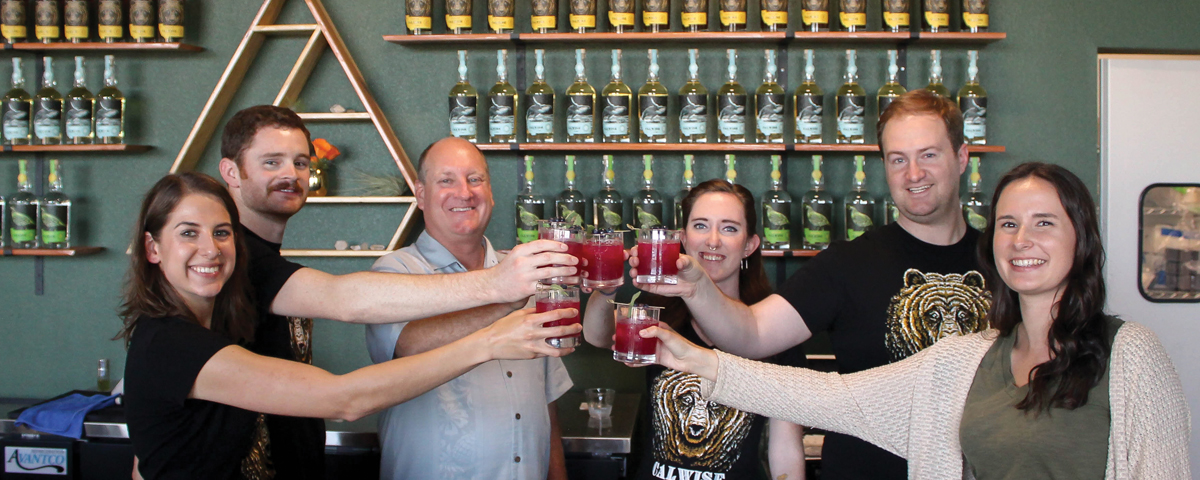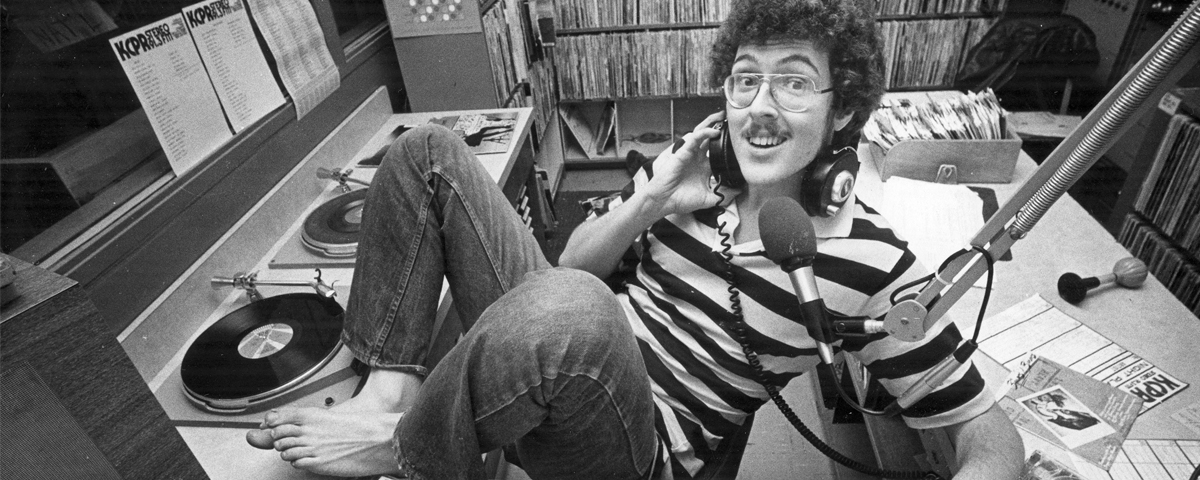In the world of entertainment, the work that goes on behind the scenes is essential to what you see on the screen. Meet six industry professionals who got their start at Cal Poly and have gone on to help make some of your favorite movies and TV shows, from The West Wing to Westworld.
Profiles by Larry Peña and Robyn Kontra Tanner
Illustrations by Jon Marchione
Kevin Falls
This past February, Cal Poly alumnus Kevin Falls, a veteran screenwriter, producer and series creator, began a new role as co-executive producer on the third season of the NBC drama “This is Us.”
The massively popular tearjerker isn’t Falls’ first hit show. For three seasons, working under head writer and creator Aaron Sorkin, Falls ran the writers’ room of “The West Wing,” an Emmy-winning drama that the Writer’s Guild of America has called as one of the best-written shows of all time.
The famously smart and fast-paced show portrays the inner workings of a fictional American presidential administration staffed by brilliant and public service-minded advisors working to tackle the early aughts’ biggest social issues.
“Probably about 50 percent of that show wouldn’t hold up today, just because of the tenor of politics now,” he says. “I think part of what makes it so enduring is that given the negativity of politics today people want to revisit the show as comfort food.”
There has never been a project where I said, ‘Well that was a waste of time.’
A former newspaper journalist, Falls sought a career change as an outlet for his desire to write more creatively. That investigative background seems to have helped him in his second career. “I’ve always been drawn to shows that lift up the hood on how something works on the inside–whether it’s behind the scenes at a cable sports network or in the White House,” he says.
Some of Falls’ other work includes serving as head writer on another Sorkin-created series, “Sports Night,” which won critical acclaim but only lasted two seasons; co-creating the lighthearted legal show “Franklin and Bash,” which ran for four seasons on TBS; the time travel cult hit “Journeyman” on NBC and producing “Pitch,” a drama about a female pitcher joining the Major Leagues that never quite found its audience.
While earlier cancellations are disappointing, he says, he’s never regretted the work he’s put into a series. “There has never been a project where I said, ‘Well that was a waste of time,'” he says. “You learn something important from every show you work on.”
That said, he says it feels good to be back on a bona fide hit series like “This Is Us.” “I’m happy to be working with an extraordinary group of writers,” he says. “It’s the second time in my career that I’m on a groundbreaking broadcast TV show – that just doesn’t happen anymore.”
Scott Wheeler
Scott Wheeler’s prolific career as a makeup artist began at Cal Poly in 1981 as a promising architecture student with an affinity for the Cal Poly Theater Department’s productions. A piece of remarkably simple guidance from Professor Michael Malkin set him on his way toward a career in makeup.
“I know these words verbatim: he said, ‘Someone’s going to do it, why not you?'”
Once Wheeler landed in Hollywood, he cut his teeth on the sets of 80s action and horror flicks like “Howling II” and “American Ninja 3: Blood Hunt.” Soon, he built a sturdy resumé working with prosthetics and special effects makeup techniques across genres in both film and television.
Someone’s going to do it, why not you?
Wheeler’s hard work opened an intergalactic door to the tv series “Star Trek: Deep Space Nine” and “Star Trek: Voyager,” where Wheeler’s teams won Emmys for makeup artistry. The success led him to the set of the franchise’s feature film “Star Trek: First Contact” in 1996. Wheeler reveled in the chance to design a new character – the Borg Queen - from scratch, armed only with script notes suggesting the being was “hauntingly beautiful.” His imagination ran wild.
“I [came] up with a whole backstory and [tried] to reason out everything I did on the design,” he recalled. “That was actually one of those rare situations where I got to go back to my architecture training and did what we call a program.” Wheeler says his ideas were translated directly into the final product and into his first Academy Award nomination.
Between a flood of feature-length projects, Wheeler went back to the small screen to develop character makeup concepts with “MADtv” in the early 2000s. Upstart comedians Jordan Peele and Keegan-Michael Key landed in his makeup chair as they made their debuts in new sketches. The trio stayed in contact, which gave Wheeler the chance to serve as makeup department head on the sketch comedy series “Key and Peele.” The show was a hit, and Wheeler made space on his mantle for a third Emmy award.
“For me, the future really is going to be mostly with Jordan Peele,” said Wheeler, who developed special effects makeup on Peele’s horror smash “Get Out.” Now, Wheeler is busy working on Peele’s hotly-anticipated thriller “Us,” due in theaters in March 2019.
Teal Owyang
As a child, Teal Owyang loved animated movies. Disney’s “The Little Mermaid” was a particular favorite. She knew early on that she wanted to be a part of the magic of making those stories come to life. There was just one problem.
“I actually can’t draw,” she says. “For a long time, I thought that was a requirement for a job like that.”
Then in 2003, she saw the Pixar film “Finding Nemo,” which marked a milestone in the development of computer-based animation. It was the first time she realized that creating the films she loved could involve skills beyond the traditional visual arts. She took high school film classes, and at Cal Poly, she majored in computer science with an eye set on animation technology.
Today Owyang is a technical director at Disney Animation Studios, where she develops the digital tools that help animators create the images the audience will see on the screen.
I cried the first time I watched ‘Zootopia’ … the fact that it was my first credit may be a factor.
Workflow protocols that she has helped develop allow teams of artists to simultaneously work on the same part of the film at the same time, helping streamline the animation process from a multi-year endeavor to generally a single year.
A new tool she has been working on recently, for use in movies including “Ralph Breaks the Internet” and the upcoming sequel to “Frozen,” lets the artists build film assets within the environment they will appear in on-screen.
So far, she has been credited for her work on the films “Zootopia” and “Moana,” and more credits are on the way. “I cried the first time I watched ‘Zootopia,'” she says. It was such a good movie, story-wise and from a technical perspective – but the fact that it was my first credit may also be a factor.”
If anything, working behind the scenes at Disney Animation has increased her love of the medium, adding the appreciation of the technical side of animation to the childhood love of a good story beautifully told.
“My favorite part of this job is the first reason I came here: being part of creating the awesome films we make, films that I enjoy personally,” she says. “Then again, getting into Disneyland for free is nice, too.”
Sahara Bushue
Sahara Bushue (Journalism ’08) originally thought her connection to the small screen would be as a broadcast anchor. But with the guidance of journalism Professor John Soares, she shifted gears toward entertainment and found an in via the infamous NBC Page program.
“You don’t really have to know anyone with Hollywood connections to start a career here,” she discovered. “You just have to be willing to hustle hard enough to meet the right people and prove your passion for entertainment.”
As she worked her way up to senior vice president in the network’s Alternative Programming division, Bushue has seen unscripted television – competitions, game shows and other reality programs – evolve beyond repetitive constructs that relied on shock value in the early 2000s.
Now she helps NBC gear storytelling toward the network’s guiding themes: inherent ingenuity, human-first stories and fundamental positivity. “You want your whole family to be able to watch and enjoy it – it’s about something more meaningful,” she says about programs like “America’s Got Talent.”
You just have to be willing to hustle hard enough to meet the right people and prove your passion for entertainment.
“I realized that I could touch a lot of people through these amazing shows that I am lucky enough to be part of.”
Bushue serves as the all-knowing melting pot of ratings totals, final cuts and distribution strategy between the show’s producers to NBC’s internal teams for several shows in production, including “World of Dance” and “Ellen’s Game of Games.”
Her job as a whole has shifted significantly as consumers flock toward on-demand digital content and seem to drain away from structured broadcast TV. Bushue’s expertise enables her shows to syndicate impactful clips and inspire digital spinoff series via social media and streaming platforms, driving viewers back to the original NBC broadcasts.
“My job at all times has to be creating the next big hit,” she says. “Instead of having fear of what goes viral, just become what goes viral!”
Justin Trudeau
Justin Trudeau (no, not the Canadian one) was never going to last long as a real-world architect. Why would he spend his time designing office buildings and playground equipment, he says, when he could be creating intergalactic space ships?
After graduating from Cal Poly’s landscape architecture program and completing graduate studies in architecture, none of the jobs he worked seemed to give him the opportunity to fully flex his creativity.
Then the self-described “huge sci-fi nerd” read an article about a movie set designer. “I had never even realized that existed,” he says. He decided on a career change and launched a relentless email campaign to beg for work from any set designer he could find. It actually worked.
In the course of his relatively short career in set design, he’s already logged some major credits. After working on the futuristic sci-fi films “Equals” and “Allegiant” in 2015 and 2016, he helped design the much more everyday interiors that served as the backdrop for the hit Netflix series “Stranger Things.”
Then it was back into the fantastical. In 2017, Trudeau got a chance to work for Marvel Studios, designing Star-Lord’s spacecraft from “Guardians of the Galaxy Vol. 2,” and the interior of the Stark transport aircraft featured in the climactic fight of “Spider-Man: Homecoming.”
If you can imagine it, and it looks cool, they just let you do it.
The year after that, he developed set pieces for two-part epic “Avengers: Infinity War.” That production process created a conundrum in dealing with Marvel’s notoriously strict secrecy policies. “The two movies shot at the same time, so it gets tricky talking about what I built for that – I can never remember which of the movies have come out yet and which one hasn’t,” he says.
He thinks audiences might be surprised at how little of what they see on the screen in a superhero movie is just a CGI effect. “At the end of the day, it just looks better if it’s real – there’s a certain level of satisfaction to interacting with a physical object,” Trudeau says. “I honestly prefer seeing my work built to seeing it on film.”
But his favorite part of the job is the license to let his creativity truly run wild. “All the stuff you wish you could do in real-life architecture, in movies you just do it,” he says. “There are not a lot of hurdles – if you can imagine it, and it looks cool, they just let you do it.”
Mike Watson
Mike Watson’s thrilling career in Hollywood stunts has roots in the Cal Poly Rodeo arena. As a student, he transferred to Cal Poly to study business and competed in the 1977 College National Finals Rodeo.
After moving to L.A., Watson worked as a professional bull rider and an extra on TV and film sets. The TV show “Trauma Center” provided his big break when two stuntmen were injured attempting to ride a bull. Watson, who had ridden that particular bull repeatedly on the rodeo circuit, stepped up for the job and learned a valuable lesson: “Being in stunts is not about being a daredevil.”
Equestrian stunts were scant in the 80s, so Watson mastered hand-to-hand combat, stunt driving and high fall techniques. He says he “died” more than 100 times in roles on screen – sometimes several times per day. While the action was staged, the risks were often real. When Watson broke his neck badly filming “Geronimo: An American Legend,” he faced a long year of recovery.
“That’s when I got serious about studying acting, directing, writing and editing,” he recalls. “I enrolled at UCLA in their directors’ program, went to editing school and became more well-rounded as a film maker.” As Westerns came back into favor around 2000, Watson stepped into more stunt coordination roles.
Being in stunts is not about being a daredevil.
His most collaborative project was orchestrating action on the HBO Western “Deadwood” alongside creator David Milch. Sometimes, Watson says, he’d be challenged to re-choreograph an entire action sequence on the spot to capture the emotion of the moment. By contrast, Watson worked with directors like the Cohen brothers on the 2010 remake of “True Grit,” where fights were meticulously storyboarded long before the first punch was thrown.
“No action scene is going to be entirely in one shot, so you have to know camera angles and editing better than anyone on set,” Watson observes. “I firmly believe that action is editing.”
Most recently, Watson served as the stunt coordinator for the first season of the genre-bending hit “Westworld.” While the scale of show’s production was unparalleled in Watson’s career, he felt satisfied knowing the flurry of bullets and left hooks fueled each character’s twisted arc. That, he says, is the true purpose of action.






